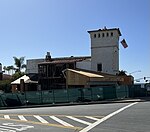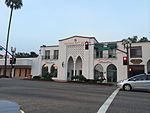USS Moray
1944 shipsBalao-class submarinesMaritime incidents in 1970Ship infoboxes without an imageShips built by William Cramp & Sons ... and 3 more
Ships sunk as targetsShipwrecks of the California coastWorld War II submarines of the United States
USS Moray (SS-300), a Balao-class submarine, was a ship of the United States Navy named for the moray, a family of large eels found in crevices of coral reefs in tropical and subtropical oceans.
Excerpt from the Wikipedia article USS Moray (License: CC BY-SA 3.0, Authors).USS Moray
San Clemente Beach Trail, San Clemente
Geographical coordinates (GPS) Address Nearby Places Show on map
Geographical coordinates (GPS)
| Latitude | Longitude |
|---|---|
| N 33.425 ° | E -117.629 ° |
Address
San Clemente Beach Trail
San Clemente Beach Trail
92674 San Clemente
California, United States
Open on Google Maps









